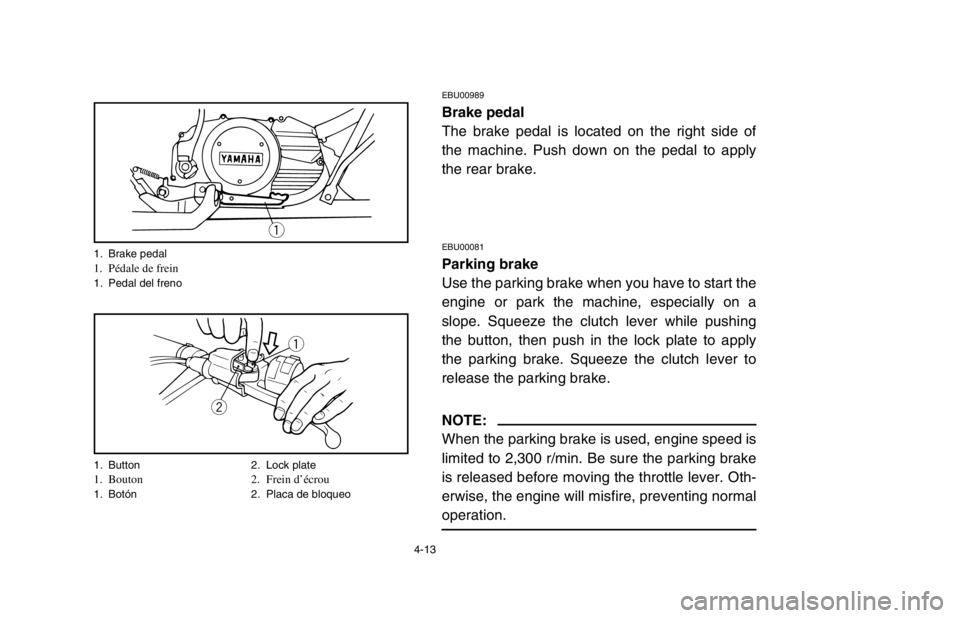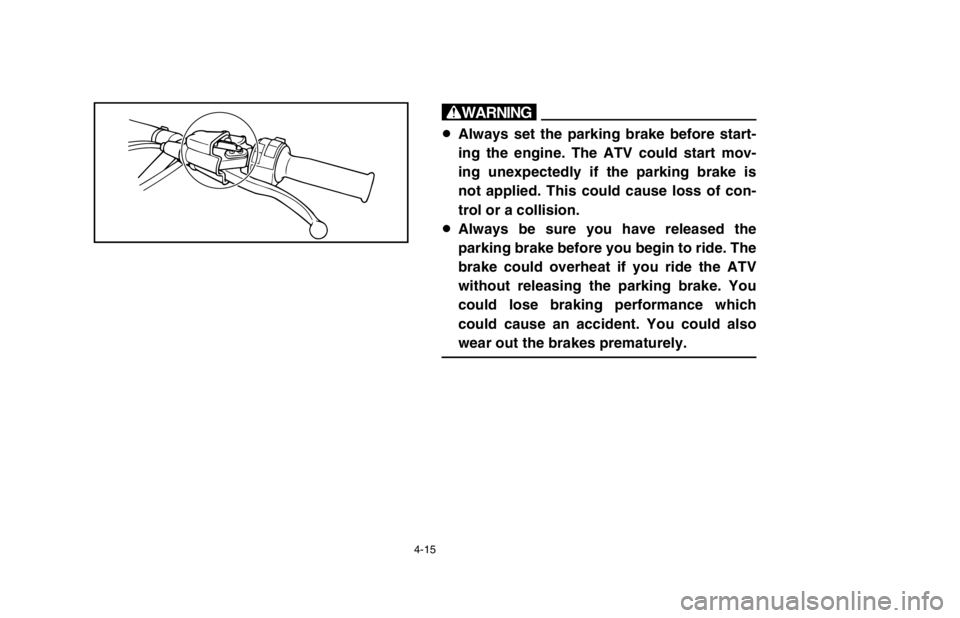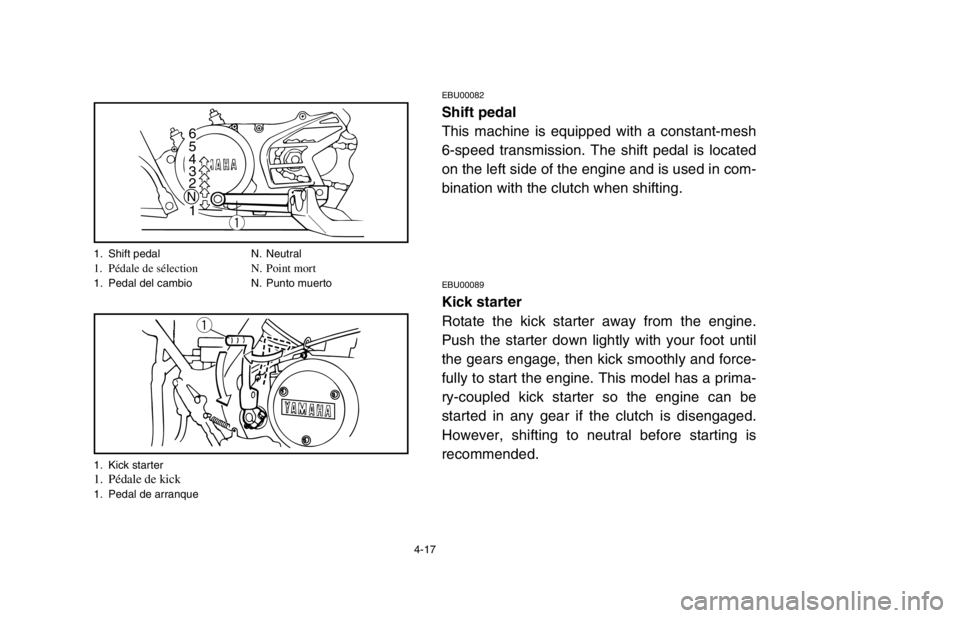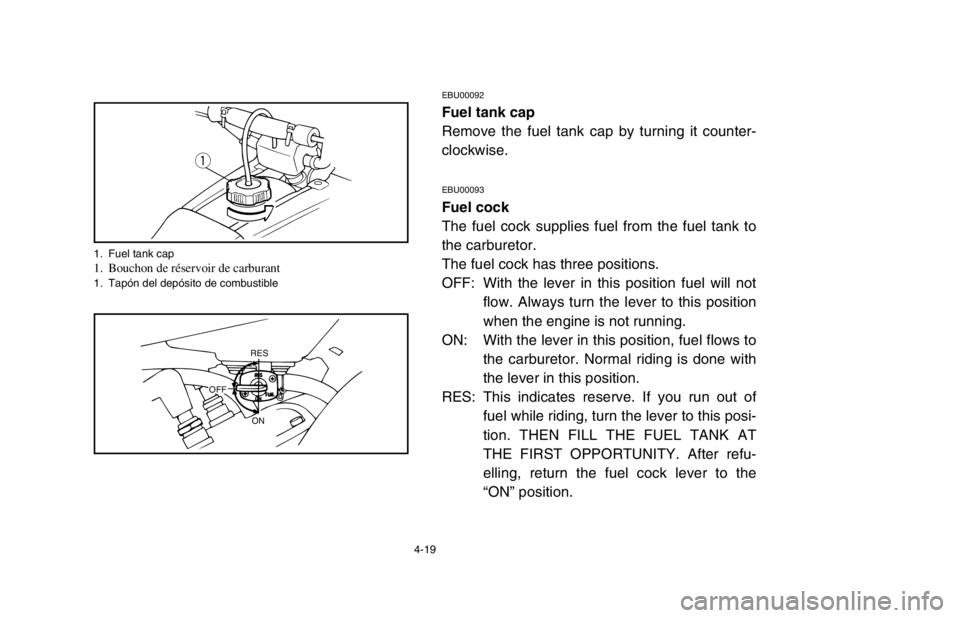engine YAMAHA BANSHEE 350R 2003 Manuale de Empleo (in Spanish)
[x] Cancel search | Manufacturer: YAMAHA, Model Year: 2003, Model line: BANSHEE 350R, Model: YAMAHA BANSHEE 350R 2003Pages: 398, tamaño PDF: 4.79 MB
Page 71 of 398

4-13
EBU00989
Brake pedal
The brake pedal is located on the right side of
the machine. Push down on the pedal to apply
the rear brake.
EBU00081
Parking brake
Use the parking brake when you have to start the
engine or park the machine, especially on a
slope. Squeeze the clutch lever while pushing
the button, then push in the lock plate to apply
the parking brake. Squeeze the clutch lever to
release the parking brake.
NOTE:
When the parking brake is used, engine speed is
limited to 2,300 r/min. Be sure the parking brake
is released before moving the throttle lever. Oth-
erwise, the engine will misfire, preventing normal
operation.
q
q
w
1. Brake pedal1. Pédale de frein 1. Pedal del freno
1. Button 2. Lock plate
1. Bouton 2. Frein d’écrou1. Botón 2. Placa de bloqueo
5FK-9-64-4~5 4/8/02 1:21 PM Page 14
Page 73 of 398

4-15
w
8Always set the parking brake before start-
ing the engine. The ATV could start mov-
ing unexpectedly if the parking brake is
not applied. This could cause loss of con-
trol or a collision.
8Always be sure you have released the
parking brake before you begin to ride. The
brake could overheat if you ride the ATV
without releasing the parking brake. You
could lose braking performance which
could cause an accident. You could also
wear out the brakes prematurely.
5FK-9-64-4~5 4/8/02 1:21 PM Page 16
Page 75 of 398

4-17
EBU00082
Shift pedal
This machine is equipped with a constant-mesh
6-speed transmission. The shift pedal is located
on the left side of the engine and is used in com-
bination with the clutch when shifting.
EBU00089
Kick starter
Rotate the kick starter away from the engine.
Push the starter down lightly with your foot until
the gears engage, then kick smoothly and force-
fully to start the engine. This model has a prima-
ry-coupled kick starter so the engine can be
started in any gear if the clutch is disengaged.
However, shifting to neutral before starting is
recommended.
1q
2 3 4 5 6N
q
1. Shift pedal N. Neutral1. Pédale de sélection N. Point mort1. Pedal del cambio N. Punto muerto
1. Kick starter
1. Pédale de kick1. Pedal de arranque
5FK-9-64-4~5 4/8/02 1:21 PM Page 18
Page 77 of 398

4-19
EBU00092
Fuel tank cap
Remove the fuel tank cap by turning it counter-
clockwise.
EBU00093
Fuel cock
The fuel cock supplies fuel from the fuel tank to
the carburetor.
The fuel cock has three positions.
OFF: With the lever in this position fuel will not
flow. Always turn the lever to this position
when the engine is not running.
ON: With the lever in this position, fuel flows to
the carburetor. Normal riding is done with
the lever in this position.
RES: This indicates reserve. If you run out of
fuel while riding, turn the lever to this posi-
tion. THEN FILL THE FUEL TANK AT
THE FIRST OPPORTUNITY. After refu-
elling, return the fuel cock lever to the
“ON” position.
q
RES
ON
OFF
1. Fuel tank cap1. Bouchon de réservoir de carburant1. Tapón del depósito de combustible
5FK-9-64-4~5 4/8/02 1:21 PM Page 20
Page 79 of 398

4-21
EBU00094
Starter (choke)
Starting a cold engine requires a richer air-fuel
mixture. A separate starter circuit supplies this
mixture.
Move in direction ato turn on the starter
(choke).
Move in direction bto turn off the starter
(choke).
Refer to “Starting a cold engine” for proper oper-
ation. (See page 6-3.)
q
ab
1. Starter (choke)1. Starter (choke)1. Starter (choke)
5FK-9-64-4~5 4/8/02 1:21 PM Page 22
Page 109 of 398

5-13
w
8Do not overfill the fuel tank. Fuel expands
when it heats up. If the fuel tank is over-
filled, fuel could spill out due to heat from
the engine or the sun.
8Be careful not to spill fuel, especially on
the engine or exhaust pipe which can
cause a fire and severe injury. Wipe up any
spilled fuel immediately.
8Do not refuel right after the engine has
been running and is still very hot.
8Be sure the fuel tank cap is closed secure-
ly.
5FK-9-64-4~5 4/8/02 1:21 PM Page 52
Page 111 of 398

5-15
EBU00132
Engine mixing oil
If Yamalube “R” oil is not available, select an oil
from the following list.
cC
Never mix two types of oil in the same batch.
Always use the same type of oil to ensure
maximum engine performance.
Recommended oil:
Yamalube “R”
(Yamalube Racing 2-cycle oil)
Mixing ratio: 24:1
Recommended oil Mixing ratio
Castrol R30
A545 20:1
A747
5FK-9-64-4~5 4/8/02 1:21 PM Page 54
Page 115 of 398

5-19
cC
8In order to prevent clutch slippage (since
the engine oil also lubricates the clutch),
do not mix any chemical additives. Do not
use oils with a diesel specification of “CD”
or oils of a higher quality than specified. In
addition, do not use oils labeled “ENERGY
CONSERVING
II” or higher.
8Make sure that no foreign material enters
the crankcase.
5FK-9-64-4~5 4/8/02 1:21 PM Page 58
Page 131 of 398

6-3
EBU00512
Starting a cold engine
w
Always make sure all control cables work
smoothly before you begin riding in cold
weather. If the control cables are frozen or
do not work smoothly, you could be unable
to control the ATV, which could lead to an
accident or collision.
1. Set the parking brake.
2. Turn the fuel cock to “ON”.
3. Turn the main switch to “ON” and the engine
stop switch to “RUN”.
4. Shift the transmission into neutral.
5. Use the starter (choke) in reference to the
figure:
5FK-9-64-6 4/8/02 1:22 PM Page 4
Page 133 of 398

6-5
Position 1: Cold engine start-
ambient temperature below 5°C.
Position 2: Cold engine start-
ambient temperature at 0°C–30°C
and warming up position.
Position 3: Cold engine start-
ambient temperature above 25°C
and warm engine start position.
6. Completely close the throttle lever and start
the engine by kicking the kick starter.
7. If the engine is started with the starter
(choke) in position 1, the starter (choke)
should be returned to position 2to warm up
the engine. If the engine is started with the
starter (choke) in position 2, keep the
starter (choke) in this position to warm up
the engine.
1. Fully open 2. Half open
3. Closed a. Starter (choke)
1. Pleine course 2. Mi-course
3. Fermé a. Starter (choke)
1. Abierto completamente 2. Semiabierto
3. Cerrado a. Starter (choke)
e q
0°10°20°30°
°C AMBIENT TEMP. / STARTER (CHOKE) POSITION
POSITION DE STARTER (CHOKE)/TEMP. AMBIANTE
POSICION DEL STARTER (CHOKE)/TEMP. AMBIENTE
w
e q
w
a
5FK-9-64-6 4/8/02 1:22 PM Page 6